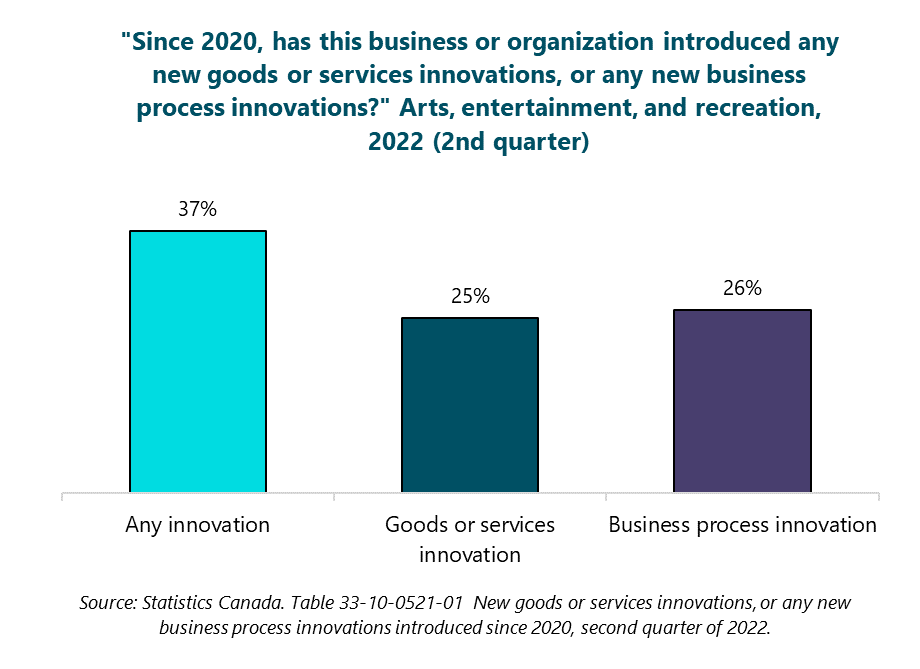Leaders in innovation: the arts, heritage, and entertainment
A pan-Canadian analysis of self-reported innovation since the start of the pandemic
Statistics Canada recently surveyed organizations and businesses (with at least one employee) about their innovations, if any, since the start of the pandemic. In this post, I analyze the collective responses of organizations and businesses in the arts, heritage, and entertainment. My key finding:
Arts, heritage, and entertainment organizations and businesses have been innovation leaders in Canada since the start of the pandemic.
Today’s post examines data for Canada as a whole. Next week, I’ll examine some key indicators by province. And, if you’re interested in qualitative information on this topic from across the country, check out our major project released earlier this year with 29 stories of innovation and resilience by artists and cultural organizations.
Today’s statistics are based on the following question, included in a survey conducted between April 1 and May 6, 2022:
Since 2020, has this business or organization introduced any new goods or services innovations, or any new business process innovations?
An innovation must be new to this business or organization, but it does not need to be new to its market.
Select all that apply.
Goods or services innovation: This refers to a new or improved good or service that differs significantly from the business's or organization's previous goods or services, with respect to its characteristics, functions or performance specifications and that has been introduced on the market.
Business process innovation: This refers to a new or improved process that differs significantly from the business's or organization's previous business processes and that has been brought into use. Include innovations in distribution or logistics, marketing or sales methods, information and communication systems, strategic and general business management practices, or process related to product or business process development.
Don't know
None of the above
Innovation leaders in the arts, heritage, and entertainment (as well as in information and cultural industries)
One-quarter of businesses and organizations across all industries in Canada (24%) reported introducing an innovation in their products and/or processes since 2020.
Among 16 industry groups, organizations and businesses in the arts, entertainment, and recreation were second most likely to have innovated since 2020 (37%).
As shown in the graph below, the only sector with a higher proportion of innovating organizations and businesses is the “information and cultural industries” group (41%).
Unfortunately, it is not possible to get access to the full dataset to investigate whether innovating organizations and businesses consider themselves better off than non-innovating organizations and businesses. (Organizations that are better or worse off is a topic I addressed a few weeks ago).
Notes: “Arts, entertainment, and recreation” (what I sometimes call “arts, heritage, and entertainment”) includes performing arts, spectator sports, and related industries (code 711); heritage institutions (code 712); amusement, gambling, and recreation industries (code 713).
The information and cultural industries group includes publishing industries (except internet) (code 511); Motion picture and sound recording industries (code 512); Broadcasting (except internet) (code 515); Telecommunications (code 517); Data processing, hosting, and related services (code 518); Other information services (code 519).
Innovations in products and/or processes since 2020
Organizations and businesses in the arts, entertainment, and recreation were equally likely to have introduced innovations in their goods and services offered (25% of all respondents) or in their business processes (26%), as shown in the following graph. Many innovators have implemented both types of innovations, as the two breakdown statistics (25% and 26%) add up to much more than the summary statistic (37%).
Goods or services innovation refers to significant differences in “characteristics, functions or performance specifications”. Business process innovation includes “innovations in distribution or logistics, marketing or sales methods, information and communication systems, strategic and general business management practices, or process related to product or business process development”. They roughly equate to “doing different things” or “doing things differently”.
In both categories, organizations and businesses in the arts, entertainment, and recreation have been highly innovative compared with other industries. Regarding goods and services innovation, the arts, entertainment, and recreation group ranks 2nd among 16 industry groups (behind only manufacturing). Regarding business process innovation, the arts, entertainment, and recreation ranks 3rd (behind information and cultural industries as well as finance and insurance).
The information and cultural industries group ranks fourth in the prevalence of goods and services innovation (22%) and first in the prevalence of business process innovation (30%).
Pandemic necessity => innovation in the arts, heritage, and entertainment
Given pandemic-induced closures and uncertainty in the arts and heritage, it is not surprising that 88% of innovating organizations and businesses in the arts, entertainment, and recreation industry group indicated that their innovations were in response to the COVID-19 pandemic.
However …
For some organizations and businesses, the pandemic has lessened their ability to innovate.
When asked if “the COVID-19 pandemic affected any of this business's or organization's activities related to innovation”, many organizations and businesses in the arts, entertainment, and recreation indicated that their activities have been delayed or cancelled. Only 20% indicated that their plans had been accelerated:
Mostly accelerated: 20%
Mostly unchanged: 30%
Mostly delayed: 19%
Most innovation activities were cancelled: 12%
Don't know: 20%



